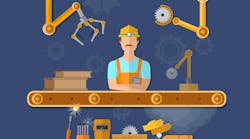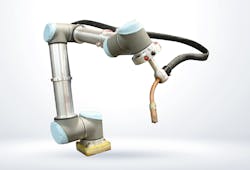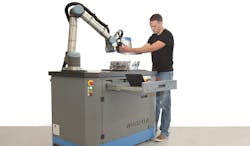In 2017, collaborative robots (cobots) began to overtake the robotic market. According to BIS Research, by 2021, the collaborative-robot market is expected to grow to approximately $2 billion and 150,000 units. Several industries are looking towards cobots as a way of introducing the new automation future.
Cobots excel because they can function in areas of work previously occupied only by their human counterparts. They are designed with inherent safety features like force feedback and collision detection, making them safe to work right next to human operators. Universal Robots is one of the leaders in the cobot market. The company’s recent white paper listed the most seven common applications for cobots.
Pick and Place
The robot above is a typical example of a pick and place robot. These robots can identify parts or objects and package them accordingly. (Image courtesy of JLS Automation)
Manual pick and place is one of most repetitive tasks performed by human workers today. The mundane nature of the task can often lead to mistakes, while the repeated physical motions can lead to strain or injury. Pick and place applications are a good start for first-time cobot users. A pick and place task is any in which a workpiece is picked up and placed in a different location. This could mean a packaging function or a sort function from a tray or conveyor; the later often requires advanced vision systems. Pick and place functions typical require an end-effector that can grasp the object. It could either be a gripper or vacuum cup effector.
Machine Tending
Machine tending requires a person to stand for long hours in front of a CNC machine, injection-modeling machine, or another similar device and tend to its operational needs. This could be tool changes or replacement of raw materials. The process is long and tiresome for the human operator. Not only do cobots free up the human operator, but a single cobot can also tend to multiple machines, leading to increased productivity. These type of cobot applications may require the cobot to have input and output (I/O) interfacing hardware specific to the machine. The I/O hardware indicates to the robot the next cycle or when material needs to be replenished.
Packaging and Palletizing
A subset of the pick and place is the packaging and palletizing of products. Products before leaving the factory floor need to be properly prepared for shipment. This may include shrink-wrapping; box assembly and loading; and box collating or placing onto a pallet for shipping. These tasks are repetitive and involve small payloads, making them ideal for cobots. Rapid product changeover is key for any business running a high to low mix of volume production. Conveyor tracking is required for this application to synchronize robotic movement with a conveyor. A vision system also may be needed for products with a non-uniform shape.
Process Tasks
Universal Robots is one of the few cobots that have a specially designed welding end-effector. Other cobots have different end-effectors such as glue dispensers for different process tasks. (Image courtesy of Universal Robots)
A process task is any that requires a tool to interact with a workpiece. Common examples are a gluing processing, dispensing, or welding. Each of these process tasks requires a tool to go down a fixed path repeatedly. These process tasks take a significant time to train new employees to obtain the required finish. By using a cobot, the programming can be performed on one unit and copied to others. The cobot also solves the problem of having a worker performing precise and repetitive movements. Traditional welding robot systems, for example, require expertise in robot programming and welding techniques.
The benefit of many cobot systems are the ease of programming either through place and position record methods or traditional CAD/CAM programming, easing the robotic programming and allowing anyone with welding experience to program a cobot. A polyscope interface helps maintain a constant TCP speed. This guarantees the robot deposits material at a constant rate. The end-effectors in these cases are unique as they need to hold a welding torch, sealant, glue, or solder paste.
Finishing Tasks
Finishing tasks performed by human operators require a manual tool and large amount of force. The vibration from the tool can cause injury to the operator. A cobot can provide the necessary force, repetition, and accuracy required for finishing jobs. These finishing jobs can include polishing, grinding, and deburring. The robot can be taught manually or via computer programming methods. Cobots that have force control can help make the robot more robust. This allows the robot to deal with different dimensioned parts. This is achieved through force sensing, either via the end-effector or internally.
Quality Inspection
Alicona uses its 3D metrology inspection cameras in conjunction with UR cobot arms for fast and easy visual inspection. (Image courtesy of Alicona)
The last task that can be accomplished via a robot is quality inspection of parts. The process usually involves full inspection of finished parts, high resolution images for precision machined parts, and part verification against CAD models. Mounting multiple high-resolution cameras onto cobots can automate the process for faster results. The inspection can also be captured digitally and digitize the comparison to computer generated model process. Using cobots for inspection can result in higher-quality inspection, resulting in more accurate production batches. End-effectors with high-resolution cameras may be required for the inspection, as well as vision systems and software.




